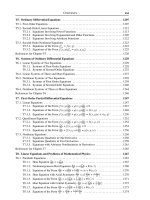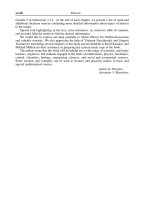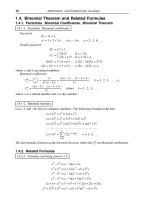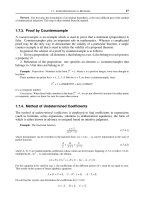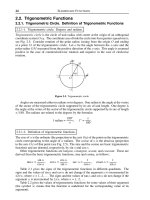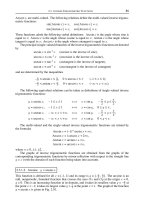Handbook of mathematics for engineers and scienteists part 203 ppsx
Bạn đang xem bản rút gọn của tài liệu. Xem và tải ngay bản đầy đủ của tài liệu tại đây (341.87 KB, 7 trang )
1382 SYSTEMS OF PARTIAL DIFFERENTIAL EQUATIONS
Solution:
u
m
= ϕ
m
(t)F
n
(t)
θ(x
1
, , x
n
, t)+
g(t, ϕ
1
, , ϕ
n–1
)
F
n
(t)
dt
, m = 1, , n – 1,
u
n
= F
n
(t)
θ(x
1
, , x
n
, t)+
g(t, ϕ
1
, , ϕ
n–1
)
F
n
(t)
dt
,
F
n
(t)=exp
f
n
(t, ϕ
1
, , ϕ
n–1
) dt
,
where the functions ϕ
m
=ϕ
m
(t) are described by the nonlinear system of first-order ordinary
differential equations
ϕ
m
= ϕ
m
[f
m
(t, ϕ
1
, , ϕ
n–1
)–f
n
(t, ϕ
1
, , ϕ
n–1
)], m = 1, , n – 1,
and the function θ = θ(x
1
, , x
n
, t) satisfies the linear equation
∂θ
∂t
= L[θ].
3.
∂u
m
∂t
= L[u
m
] +
n
k=1
u
k
f
mk
t,
u
1
u
n
, ,
u
n–1
u
n
, m =1, , n.
Here, the system involves n
2
arbitrary functions f
mk
= f
mk
(t, z
1
, , z
n–1
) that depend
on n arguments; L is an arbitrary linear differential operator with respect to the spatial
variables x
1
, , x
n
(of any order in derivatives), whose coeffi cients can be dependent on
x
1
, , x
n
, t. It is assumed that L[const] = 0.
Solution:
u
m
(x
1
, , x
n
, t)=ϕ
m
(t)F (t)θ(x
1
, , x
n
, t), m = 1, , n,
F (t)=exp
n
k=1
ϕ
k
(t)f
nk
(t, ϕ
1
, , ϕ
n–1
) dt
, ϕ
n
(t)=1,
where the functions ϕ
m
=ϕ
m
(t) are described by the nonlinear system of first-order ordinary
differential equations
ϕ
m
=
n
k=1
ϕ
k
f
mk
(t, ϕ
1
, , ϕ
n–1
)–ϕ
m
n
k=1
ϕ
k
f
nk
(t, ϕ
1
, , ϕ
n–1
), m = 1, , n – 1,
and the function θ = θ(x
1
, , x
n
, t) satisfies the linear equation
∂θ
∂t
= L[θ].
References for Chapter T10
Barannyk, T., Symmetry and exact solutions for systems of nonlinear reaction-diffusion equations, Proc. of
Inst. of Mathematics of NAS of Ukraine, Vol. 43, Part 1, pp. 80–85, 2002.
Barannyk, T. A. and Nikitin,A. G., Proc. of Inst. of Mathematics of NAS of Ukraine, Vol. 50, Part 1, pp. 34–39,
2004.
Cherniha,R.andKing,J.R.,Lie symmetries of nonlinear multidimensional reaction-diffusion systems: I,
J. Phys. A: Math. Gen., Vol. 33, pp. 267–282, 7839–7841, 2000.
REFERENCES FOR CHAPTER T10 1383
Cherniha, R. and King, J. R., Lie symmetries of nonlinear multidimensional reaction-diffusion systems: II,
J. Phys. A: Math. Gen., Vol. 36, pp. 405–425, 2003.
Nikitin, A. G., Group classification of systems of non-linear reaction-diffusion equations with general diffusion
matrix. II. Diagonal diffusion matrix, From Website arXiv.org (a service of automated e-print archives of
articles), />Nikitin, A. G. and Wiltshire, R. J., Systems of reaction-diffusion equations and their symmetry properties, J.
Math. Phys., Vol. 42, No. 4, pp. 1667–1688, 2001.
Polyanin,A.D.,Exact solutions of nonlinear sets of equations of the theory of heat and mass transfer in
reactive media and mathematical biology, Theor. Foundations of Chemical Engineering, Vol. 38, No. 6,
pp. 622–635, 2004.
Polyanin, A. D., Exact solutions of nonlinear systems of diffusion equations for reacting media and mathemat-
ical biology, Doklady Mathematics, Vol. 71, No. 1, pp. 148–154, 2005.
Polyanin,A.D.,Systems of Partial DifferentialEquations, From Website EqWorld—The World of Mathematical
Equations, />Polyanin, A. D. and Vyaz’mina, E.A., New classes of exact solutions tononlinear systems of reaction-diffusion
equations, Doklady Mathematics, Vol. 74, No. 1, pp. 597–602, 2006.
Polyanin, A. D. and Zaitsev, V. F., Handbook of Exact Solutions for Ordinary Differential Equations, 2nd
Edition, Chapman & Hall/CRC Press, Boca Raton, 2004.
Chapter T11
Integral Equations
T11.1. Linear Equations of the First Kind
with Variable Limit of Integration
1.
x
a
(x – t)y(t) dt = f (x), f(a) = f
x
(a) =0.
Solution: y(x)=f
xx
(x).
2.
x
a
(Ax + Bt + C)y(t) dt = f (x), f(a) =0.
1
◦
. Solution for B ≠ –A:
y(x)=
d
dx
(A + B)x + C
–
A
A+B
x
a
(A + B)t + C
–
B
A+B
f
t
(t) dt
.
2
◦
. Solution for B =–A:
y(x)=
1
C
d
dx
exp
–
A
C
x
x
a
exp
A
C
t
f
t
(t) dt
.
3.
x
a
(x – t)
n
y(t) dt = f (x), n =1, 2,
It is assumed that the right-hand side of the equation satisfies the conditions f(a)=f
x
(a)=
···= f
(n)
x
(a)=0.
Solution: y(x)=
1
n!
f
(n+1)
x
(x).
4.
x
a
√
x – ty(t) dt = f (x), f(a) =0.
Solution: y(x)=
2
π
d
2
dx
2
x
a
f(t) dt
√
x – t
.
5.
x
a
y(t) dt
√
x – t
= f(x).
Abel equation.
Solution:
y(x)=
1
π
d
dx
x
a
f(t) dt
√
x – t
=
f(a)
π
√
x – a
+
1
π
x
a
f
t
(t) dt
√
x – t
.
1385
1386 INTEGRAL EQUATIONS
6.
x
a
(x – t)
λ
y(t) dt = f(x), f(a) =0, 0<λ <1.
Solution: y(x)=
sin(πλ)
πλ
d
2
dx
2
x
a
f(t) dt
(x – t)
λ
.
7.
x
a
y(t) dt
(x – t)
λ
= f(x), 0<λ <1.
Generalized Abel equation.
Solution:
y(x)=
sin(πλ)
π
d
dx
x
a
f(t) dt
(x – t)
1–λ
=
sin(πλ)
π
f(a)
(x – a)
1–λ
+
x
a
f
t
(t) dt
(x – t)
1–λ
.
8.
x
a
e
λ(x–t)
y(t) dt = f (x), f(a) =0.
Solution: y(x)=f
x
(x)–λf(x).
9.
x
a
e
λx+βt
y(t) dt = f (x), f(a) =0.
Solution: y(x)=e
–(λ+β)x
f
x
(x)–λf(x)
.
10.
x
a
e
λ(x–t)
–1
y(t) dt = f (x), f(a) = f
x
(a) =0.
Solution: y(x)=
1
λ
f
xx
(x)–f
x
(x).
11.
x
a
e
λ(x–t)
+ b
y(t) dt = f(x), f (a) =0.
For b =–1, see equation T11.1.10.
Solution for b ≠ –1:
y(x)=
f
x
(x)
b + 1
–
λ
(b + 1)
2
x
a
exp
λb
b + 1
(x – t)
f
t
(t) dt.
12.
x
a
e
λ(x–t)
– e
μ(x–t)
y(t) dt = f(x), f(a) = f
x
(a) =0.
Solution:
y(x)=
1
λ – μ
f
xx
–(λ + μ)f
x
+ λμf
, f = f(x).
13.
x
a
y(t) dt
√
e
λx
– e
λt
= f(x), λ >0.
Solution: y(x)=
λ
π
d
dx
x
a
e
λt
f(t) dt
√
e
λx
– e
λt
.
T11.1. LINEAR EQUATIONS OF THE FIRST KIND WITH VARIABLE LIMIT OF INTEGRATION 1387
14.
x
a
cosh[λ(x – t)]y(t) dt = f(x), f(a) =0.
Solution: y(x)=f
x
(x)–λ
2
x
a
f(x) dx.
15.
x
a
cosh[λ(x – t)] –1
y(t) dt = f (x), f(a) = f
x
(a) = f
xx
(x) =0.
Solution: y(x)=
1
λ
2
f
xxx
(x)–f
x
(x).
16.
x
a
cosh[λ(x – t)] + b
y(t) dt = f (x), f(a) =0.
For b = 0, see equation T11.1.14. For b =–1, see equation T11.1.15.
1
◦
. Solution for b(b + 1)<0:
y(x)=
f
x
(x)
b + 1
–
λ
2
k(b + 1)
2
x
a
sin[k(x – t)]f
t
(t) dt,wherek = λ
–b
b + 1
.
2
◦
. Solution for b(b + 1)>0:
y(x)=
f
x
(x)
b + 1
–
λ
2
k(b + 1)
2
x
a
sinh[k(x – t)]f
t
(t) dt,wherek = λ
b
b + 1
.
17.
x
a
cosh
2
[λ(x – t)]y(t) dt = f(x), f(a) =0.
Solution:
y(x)=f
x
(x)–
2λ
2
k
x
a
sinh[k(x – t)]f
t
(t) dt,wherek = λ
√
2.
18.
x
a
sinh[λ(x – t)]y(t) dt = f(x), f(a) = f
x
(a) =0.
Solution: y(x)=
1
λ
f
xx
(x)–λf(x).
19.
x
a
sinh[λ(x – t)] + b
y(t) dt = f(x), f (a) =0.
For b = 0, see equation T11.1.18.
Solution for b ≠ 0:
y(x)=
1
b
f
x
(x)+
x
a
R(x – t)f
t
(t) dt,
R(x)=
λ
b
2
exp
–
λx
2b
λ
2bk
sinh(kx)–cosh(kx)
, k =
λ
√
1 + 4b
2
2b
.
1388 INTEGRAL EQUATIONS
20.
x
a
sinh
λ
√
x – t
y(t) dt = f (x), f(a) =0.
Solution: y(x)=
2
πλ
d
2
dx
2
x
a
cos
λ
√
x – t
√
x – t
f(t) dt.
21.
x
0
ln(x – t)y(t) dt = f (x).
Solution:
y(x)=–
x
0
f
tt
(t) dt
∞
0
(x – t)
z
e
–Cz
Γ(z + 1)
dz – f
x
(0)
∞
0
x
z
e
–Cz
Γ(z + 1)
dz,
where C = lim
k→∞
1 +
1
2
+ ···+
1
k + 1
–lnk
= 0.5772 is the Euler constant and Γ(z)is
the gamma function.
22.
x
a
[ln(x – t) + A]y(t) dt = f(x).
Solution:
y(x)=–
d
dx
x
a
ν
A
(x – t)f(t) dt, ν
A
(x)=
d
dx
∞
0
x
z
e
(A–C)z
Γ(z + 1)
dz,
where C = 0.5772 is the Euler constant and Γ(z) is the gamma function.
For a = 0, the solution can be written in the form
y(x)=–
x
0
f
tt
(t) dt
∞
0
(x – t)
z
e
(A–C)z
Γ(z + 1)
dz – f
x
(0)
∞
0
x
z
e
(A–C)z
Γ(z + 1)
dz.
23.
x
a
(x – t)
ln(x – t) + A
y(t) dt = f(x), f (a) =0.
Solution:
y(x)=–
d
2
dx
2
x
a
ν
A
(x – t)f(t) dt, ν
A
(x)=
d
dx
∞
0
x
z
e
(A–C)z
Γ(z + 1)
dz,
where C = 0.5772 is the Euler constant and Γ(z) is the gamma function.
24.
x
a
cos[λ(x – t)]y(t) dt = f (x), f(a) =0.
Solution: y(x)=f
x
(x)+λ
2
x
a
f(x) dx.
25.
x
a
cos[λ(x – t)] –1
y(t) dt = f (x), f(a) = f
x
(a) = f
xx
(a) =0.
Solution: y(x)=–
1
λ
2
f
xxx
(x)–f
x
(x).



